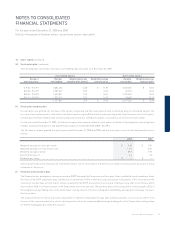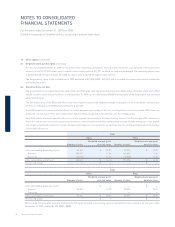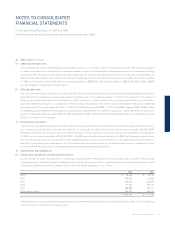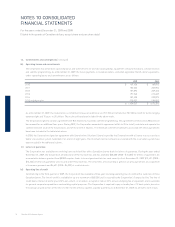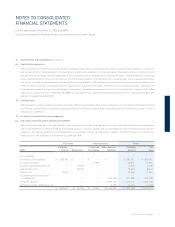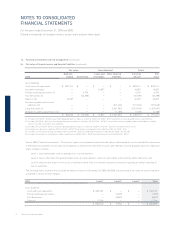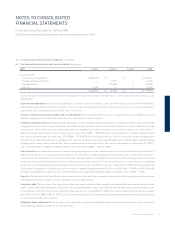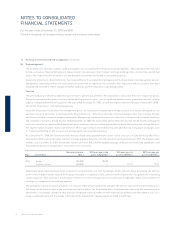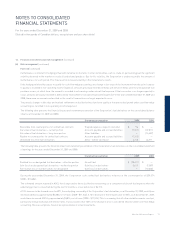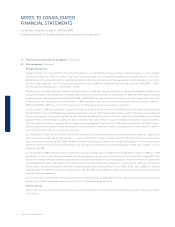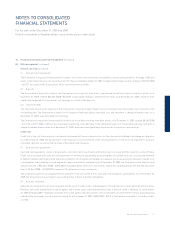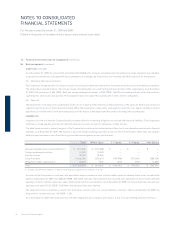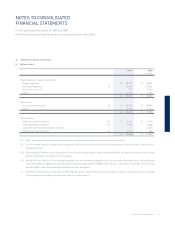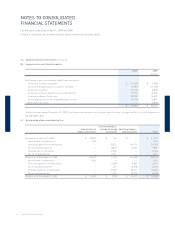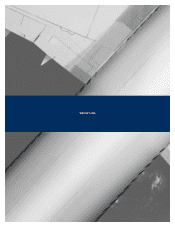Westjet 2009 Annual Report Download - page 107
Download and view the complete annual report
Please find page 107 of the 2009 Westjet annual report below. You can navigate through the pages in the report by either clicking on the pages listed below, or by using the keyword search tool below to find specific information within the annual report.
NOTES TO CONSOLIDATED
FINANCIAL STATEMENTS
For the years ended December 31, 2009 and 2008
(Stated in thousands of Canadian dollars, except share and per share data)
WestJet 2009 Annual Report 77
13. Financial instruments and risk management (continued)
(b) Risk management (continued)
Interest rate risk (continued)
(i) Cash and cash equivalents
The Corporation is exposed to interest rate fl uctuations on its short-term investments included in cash and cash equivalents. A change of 50 basis
points in the market interest rate would have had for the year ended December 31, 2009, an approximate impact on net earnings of $2,555 (2008
– $2,571) as a result of the Corporation’s short-term investment activities.
(ii) Deposits
The Corporation is exposed to interest rate fl uctuations on its deposits that relate to purchased aircraft and airport operations, which, as at
December 31, 2009, totalled $27,264 (2008 – $24,309). A reasonable change in market interest rates as at December 31, 2009, would not have
signifi cantly impacted the Corporation’s net earnings as a result of the deposits.
(iii) Long-term debt
The fi xed-rate nature of the majority of the Corporation’s long-term debt reduces the risk of interest rate fl uctuations over the term of the
outstanding debt. The Corporation accounts for its long-term fi xed-rate debt at amortized cost, and, therefore, a change in interest rates as at
December 31, 2009, would not impact net earnings.
The Corporation is exposed to interest rate fl uctuations on its variable-rate long-term debt, which, as at December 31, 2009, totalled $8,563 (2008
– $11,172) or 0.7% (2008 – 0.8%) of the Corporation’s total long-term debt. Due to the immaterial balance of the variable-rate long-term debt, a
change in market interest rates as at December 31, 2009, would not have signifi cantly impacted the Corporation’s net earnings.
Credit risk
Credit risk is the risk that one party to a fi nancial instrument will cause a fi nancial loss for the other party by failing to discharge an obligation.
As at December 31, 2009, the Corporation’s credit exposure consists primarily of the carrying amounts of cash and cash equivalents, accounts
receivable, deposits, as well as the fair value of derivative fi nancial assets.
(i) Cash and cash equivalents
Cash and cash equivalents consist of bank balances and short-term investments with terms of up to one year with the majority less than 91 days.
Credit risk associated with cash and cash equivalents is minimized substantially by ensuring that these fi nancial assets are invested primarily
in debt instruments with highly rated fi nancial institutions. The Corporation manages its exposure risk by assessing the fi nancial strength of its
counterparties and by limiting the total exposure to any one individual counterparty. As at December 31, 2009, the Corporation had a total principal
amount invested of $813,215 (2008 – $692,188) in Canadian-dollar short-term investments with terms ranging between fi ve and 365 days and a
total of US $nil (2008 – US $23,832) invested in US-dollar short-term investments.
The Corporation performs an ongoing review to evaluate its risk associated with its cash and cash equivalent counterparties. As at December 31,
2009, the Corporation does not expect any counterparties to fail to meet their obligations.
(ii) Accounts receivable
Generally, the Corporation’s accounts receivable are the result of tickets sold to individual guests through the use of travel agents and other airlines.
Purchase limits are established for certain agents and in some cases, when deemed necessary, a letter of credit is obtained. As at December
31, 2009, $10,374 (2008 – $7,403) is receivable from travel agents and other airlines. These receivables are short term in nature, generally being
settled within four weeks from the date of booking. As at December 31, 2009, $603 (2008 – $651) of the balance receivable is covered by letters
of credit.


